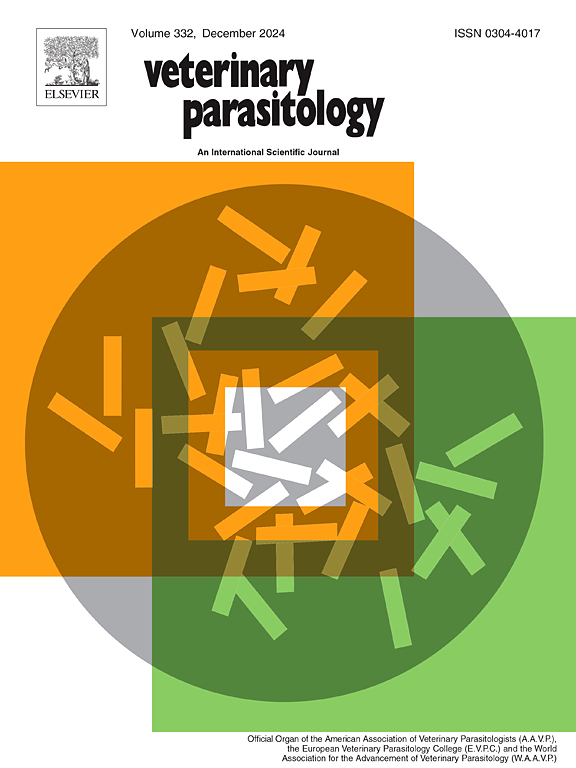伊维菌素对马强直性脊柱炎的疗效:药效、虫卵重现期和粪便虫卵计数法比较
IF 2
2区 农林科学
Q2 PARASITOLOGY
引用次数: 0
摘要
马的强眼病无处不在,可能导致严重的健康问题。虫虫耐药在胞口蛋白寄生虫中很常见,最近的研究表明,对大环内酯类药物的耐药发生率越来越高。一些欧洲国家已经通过法律实施了仅限处方使用驱虫药的限制,以减少驱虫药的治疗强度和减少耐药性的选择压力。然而,这种方法的长期效果尚未得到全面评估。目的是通过丹麦马的粪卵计数减少试验(FECRT)和卵再现期(ERP)来确定伊维菌素对圆线虫的疗效,比较两种粪卵计数技术,并确定研究人群中寻常圆线虫的患病率。畜群和马匹由四家合作兽医机构选择。共有来自30个畜群的299匹马参加了这项研究。使用浓度麦克马斯特技术和基于人工智能的自动粪蛋计数系统确定粪蛋计数(FEC)。所有FEC >; 每克粪便0个卵(EPG)的马均用伊维菌素处理。依维菌素疗效和ERP按照现行指南进行测定。采用共育法和PCR法检测葡萄球菌。基于麦克马斯特卵计数的FECRTs显示,在2例马手术中伊维菌素无效,在其余所有马种群中完全有效,而自动化系统显示6例手术中伊维菌素耐药,另外8例手术结果不确定。两种方法均测定伊维菌素ERP至少为8周。共育法和PCR法检测的普通葡萄球菌感染率分别为2.7 %和5.7 %,处理后8周和24周两种方法检测均为阴性。总体而言,伊维菌素的疗效很高,尽管一些结果表明可能出现疗效下降,这需要进一步监测。ERP估计都超过了8周,这表明没有发生减少。两种卵子计数技术总体上是一致的,但自动系统在低卵子计数水平下检测到更多的阳性,这导致一些人群的有效性估计较低。普通圆线虫在丹麦马中仍然是地方性的。本文章由计算机程序翻译,如有差异,请以英文原文为准。
Ivermectin performance against equine strongylids: Efficacy, egg reappearance periods, and fecal egg counting method comparison
Equine strongylids are ubiquitous and can cause severe health issues. Anthelmintic resistance is widely common in cyathostomin parasites, and recent studies have documented increasing incidence of resistance to the macrocyclic lactone drug class. Several European countries have implemented prescription-only restrictions of anthelmintic usage by law to reduce anthelmintic treatment intensity and decrease the selection pressure for drug resistance. However, long term outcomes of this approach have not been thoroughly evaluated. The aim was to determine ivermectin efficacy in strongylids by means of faecal egg count reduction test (FECRT) and egg reappearance period (ERP) in Danish horses, compare two fecal egg count techniques, and determine the prevalence of Strongylus vulgaris in the study population. Herds and horses were selected by four collaborating veterinary practices. A total of 299 horses from 30 herds were enrolled in the study. Fecal egg counts (FEC) were determined using a concentration McMaster technique as well as an artificial intelligence-based automated fecal egg counting system. All horses with FEC > 0 eggs per gram of feces (EPG) were treated with ivermectin. Ivermectin efficacy and ERP were determined following current guidelines. Coproculture and PCR were employed for detection of S. vulgaris. FECRTs based on McMaster egg counts suggested inconclusive ivermectin efficacy in two equine operations and full efficacy in all remaining populations, whereas the automated system suggested ivermectin resistance in 6 operations and inconclusive results in another 8. Ivermectin ERP was determined to be at least 8 weeks with both methods in all cases. The prevalence of S. vulgaris was 2.7 % and 5.7 % with coproculture and PCR, respectively, and all samples were negative with both methods at 8 and 24 weeks post treatment. In general, ivermectin efficacy was high, although some results suggest that reduced efficacy could be occurring, which warrants further monitoring going forward. The ERP estimates all exceeded 8 weeks, which suggests that no reduction has occurred. The two egg counting techniques were in general agreement, but the automated system detected more positives at low egg count levels, which led to lower efficacy estimates in some populations. Strongylus vulgaris remains enzootic in Danish horses.
求助全文
通过发布文献求助,成功后即可免费获取论文全文。
去求助
来源期刊

Veterinary parasitology
农林科学-寄生虫学
CiteScore
5.30
自引率
7.70%
发文量
126
审稿时长
36 days
期刊介绍:
The journal Veterinary Parasitology has an open access mirror journal,Veterinary Parasitology: X, sharing the same aims and scope, editorial team, submission system and rigorous peer review.
This journal is concerned with those aspects of helminthology, protozoology and entomology which are of interest to animal health investigators, veterinary practitioners and others with a special interest in parasitology. Papers of the highest quality dealing with all aspects of disease prevention, pathology, treatment, epidemiology, and control of parasites in all domesticated animals, fall within the scope of the journal. Papers of geographically limited (local) interest which are not of interest to an international audience will not be accepted. Authors who submit papers based on local data will need to indicate why their paper is relevant to a broader readership.
Parasitological studies on laboratory animals fall within the scope of the journal only if they provide a reasonably close model of a disease of domestic animals. Additionally the journal will consider papers relating to wildlife species where they may act as disease reservoirs to domestic animals, or as a zoonotic reservoir. Case studies considered to be unique or of specific interest to the journal, will also be considered on occasions at the Editors'' discretion. Papers dealing exclusively with the taxonomy of parasites do not fall within the scope of the journal.
 求助内容:
求助内容: 应助结果提醒方式:
应助结果提醒方式:


